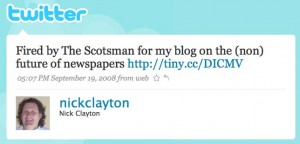There aren’t enough ad dollars on the planet for everyone, Stevie Spring, chief executive of Future, said, in her opening remarks for yesterday’s session at the 37th FIPP World Magazine Congress that looked at ‘what advertisers want’.
Magazines are ‘all having to fight much much harder to grow our share of media spend,’ she added. So, she asked, just ‘what the hell’ did advertisers want from magazines?
Nikolas Talonpoika, worldwide media director for the Gucci Group said that he thinks online will see a decrease in advertising spend from the luxury sector.
Magazines are still the most important part of the Gucci Group’s print advertising spend, Talonpoika told delegates.
While acknowledging that this year is tough and ‘lots of titles will disappear this year, Talonpoika was optimistic for the role that print magazines will continue to play.
Unilever’s CMO, Simon Clift said that for his company the ‘lion’s share’ of advertising is in television, and only 13 per cent of its overall advertising budget is spent in print – but said the magazines accounted for 90 per cent of that print spend.
Clift said that his company – which, with its £41 billion turnover, is seeing three quarters of its growth in developing and emerging markets – is thinking about different ways to promote its products via print.
For example, one Greek newspaper was once printed entirely on aromatised paper for one particular washing product campaign.
Clift said that consumers were not beginning to ‘define the agenda’ and that Unilever was looking for new ways to promote brands via editorial or advertorial content.
Clift argued that these methods ‘can build integrity rather than compromise it,’ he argued. Joking that advertising was something editors have to put up with, he said advertisers don’t want to see a publication damaged by the advertising. ‘A successful parasite doesn’t kill its host,’ he quipped.
It was about creating interesting content, he said ‘whether it comes from an editor or an advertiser’ “When those things [editorial and advertising] are parallel it magnifies and develops our message,” he said.
Dove is the Unilever brand which is most advertised in magazines, and a product which is an example of a cross-media promotion: online, in magazines and on television.
In the previous session, Maurice Lévy, chairman and CEO of the Publicis Groupe, spoke of the world ‘the ad agencies have to live in now, where a couple of words on a search engine page is sometimes considered by our client as more effective than a wonderful TV spot.’
Newspapers and magazines could not expect to retain their share in the advertising market, despite analysts’ more optimistic predictions for 2011, he said.
“We have to change and we do change each day. You have to adapt yourself to this new world,” he said.
“It’s not yet time for obituaries,” he claimed. “I’m a little bit shocked when I see print media forever discussing their own death,”
“Please always remember the small guy in the digital world – Bill Gates. He repeated loud and clear ‘content is king’ (…) and you [the magazine industry] own it.'”
“Would you go as often on the internet, if you could not find newspapers and your favourite magazines online?” he asked. “I don’t think print media is dead, quite the contrary,” Lévy added.
“Think what semantic can do when combined with marketing. Now is time to innovate.”
“You have to look at this as an opportunity to leverage new opportunities with the strength of your brand and your audiences,” he said.
